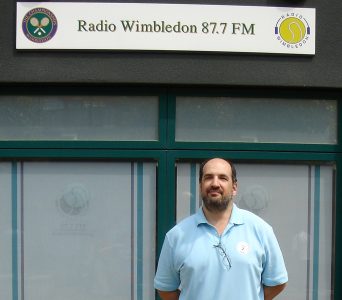
If you’re a regular reader of this site, you know we’re a little tennis-crazy in my house. My wife and I used to play several times a week, and our daughter played on the varsity team in high school. We’ve all put our rackets away over the last few years, but our love of the game thrives during the four Grand Slam events, when our DVR fills up with hour upon hour of coverage, just in case we miss anything live, or so my wife can catch up when she gets home from work. I even make them put one of the TVs in the poker room on ESPN so I can watch as much as I can.
This year is no exception. We’ve been shocked to see all the upsets at Wimbledon, where none of the ten top-seeded women made it to the quarterfinals, the round where Roger Federer was eliminated by Kevin Anderson. Yesterday, I had a bunch of errands to run, so I couldn’t watch the Nadal/Del Potro match all the way through. But I remembered that when we visited Wimbledon during a London vacation in 2006 (read the story here), we discovered there’s a Radio Wimbledon channel providing live coverage throughout the tournament. It’s a low-power FM station which only reaches a five-mile radius over the air, but is streamed worldwide and has an audience into the hundreds of thousands at this time of year. So, as I drove from errand to errand, I listened to the Radio Wimbledon feed online through my phone to keep up with the action.
It’s fascinating to hear the difference between ESPN’s announcers and the Radio Wimbledon guys. On TV, play-by-play man Chris Fowler has ably stepped into the shoes of broadcasting legend Dick Enberg, while John McEnroe remains the best analyst of any sport (with NBC’s Cris Collingsworth’s NFL work a close second), but during play they remain silent and let the pictures tell the story. On the audio stream, Wimbledon’s Nick Lester and Arv Palmer have to not only describe the action — cross-court here, backhand up the line there, a drop shot, an ace, etc. — they must keep talking between points as well as during breaks in the action when the players sit down, because there are no commercial breaks. During a five-set match, they can be on mic non-stop for four hours or more. That’s a lot of talking.
Tennis does not happen at the leisurely pace of baseball, or the structured nature of football. It’s more akin to hockey, where things go very quickly and announcers have to really be at the top of their game to make sense of it for listeners. Without video to help tell the story of each point, Lester and Palmer are quite adept at explaining what’s going on, which is not an easy job in a game where the ball is moving so fast (serves routinely top 120mph).
It’s a unique broadcasting niche, but the Radio Wimbledon team fills it beautifully.
Previously on Harris Online…
